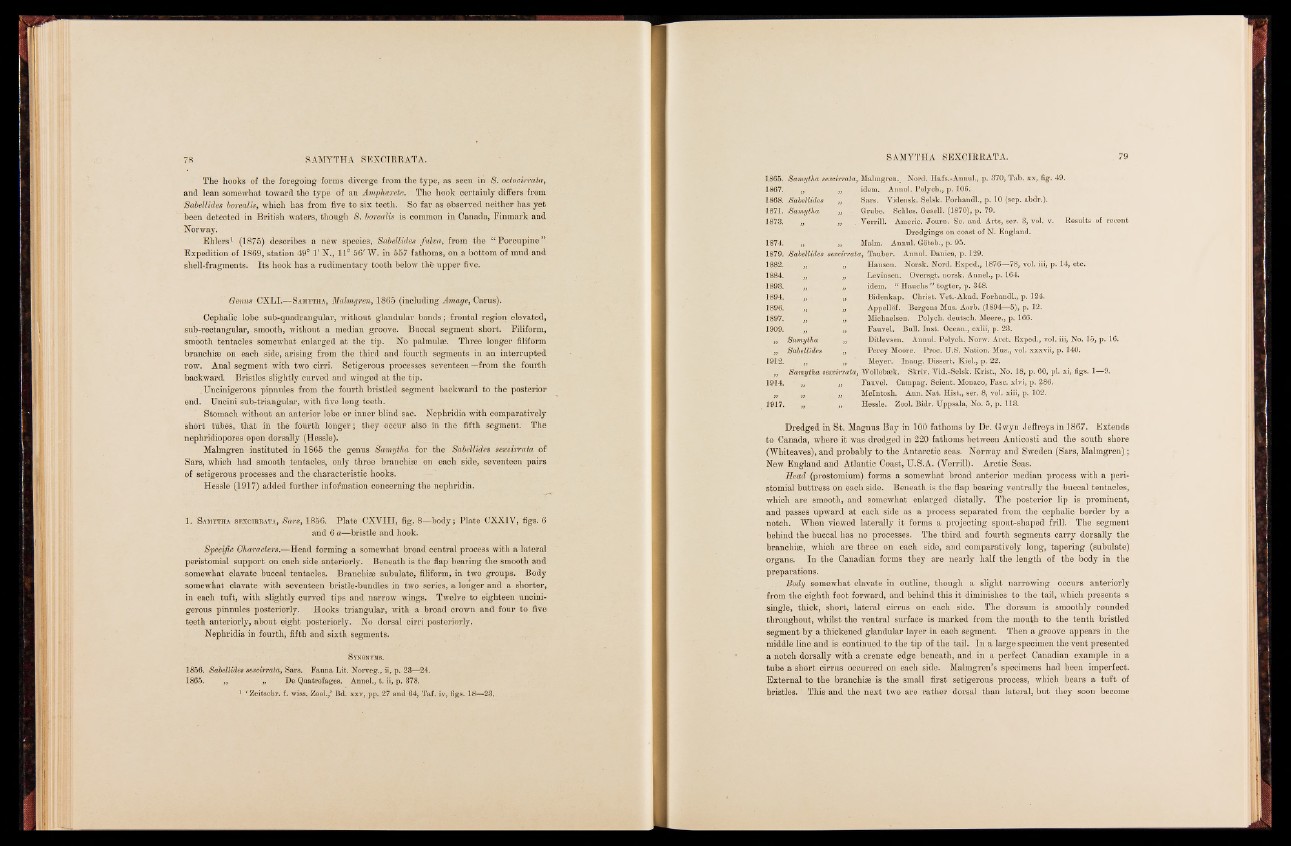
The hooks of the foregoing forms diverge from the type, as seen in 8. octociirata,
and lean somewhat toward the type of an Ampharete. The hook certainly differs from
Sabellides borealis, which has from five to six teeth. So far as observed neither has yet
been detected in British waters, though 8. borealis is common in Canada, Finmark and
Norway.
Ehlers1 (1875) describes a new species, Sabellides fidva, from the “ Porcupine”
Expedition of 1869, station 49° 1' N., 11° 56' W. in 557 fathoms, on a bottom of mud and
shell-fragments. Its hook has a rudimentary tooth below the upper five.
Qenus CXLI.—Samytha, Malmgren, 1865 (including Amage, Carus).
Cephalic lobe sub-quadrangular, without glandular bands; frontal region elevated,
sub-rectangular, smooth, without a median groove. Buccal segment short. Filiform,
smooth tentacles somewhat enlarged at the tip. No palmulae. Three longer filiform
branchiae on each side, arising from the third and fourth segments in an interrupted
row. Anal segment with two cirri. Setigerous processes seventeen—from the fourth
backward. Bristles slightly curved and winged at the tip.
Uncinigerous pinnules from the fourth bristled segment backward to the posterior
end. Uncini sub-triangular, with five long teeth.
Stomach without an anterior lobe or inner blind sac. Nephridia with comparatively
short tubes, that in the fourth longer; they occur also in the fifth segment. The
nephridiopores open dorsally (Hessle).
Malmgren instituted in 1865 the genus Samytha for the Sabellides sexcirrata of
Sars, which had smooth tentacles, only three branchiae on each side, seventeen pairs
of setigerous processes and the characteristic hooks.
Hessle (1917) added further information concerning the nephridia.
1. Samytha sexcirrata, Sars, 1856. Plate CXVIII, fig. 8—body; Plate CXXIV, figs. 6
and 6 a—bristle and hook.
Specific Characters.—Head forming a somewhat broad central process with a lateral
peristomial support on each side anteriorly. Beneath is the flap bearing the smooth and
somewhat clavate buccal tentacles. Branchiæ subulate, filiform, in two groups. Body
somewhat clavate with seventeen bristle-bundles in two series, a longer and a shorter,
in each tuft, with slightly curved tips and narrow wings. Twelve to eighteen uncinigerous
pinnules posteriorly. Hooks triangular, with a broad crown and four to five
teeth anteriorly, about eight posteriorly. No dorsal cirri posteriorly.
Nephridia in fourth, fifth and sixth segments.
S ynonyms..
1856. Sabellides sexcirrata, Sars. Fauna Lit. Norveg., ii, p. 23—24.
18,65. ,, „ " De Quatrefages. Annel., t. ii, p. 378.
1 ‘Zeitschr. f. wiss. Zool./ Bd. xxv, pp.;27 and 64, Taf. iv, figs. 18—23.
1865.
1867.
1868.
1871.
1873.
1874.
1879.
1882.
1884.
1893.
1894.
1896.
1897.
1909.
1912.
1914.
1917.
Samytha sexcirrata, Malmgren., Nord. Hafs.-Annul., p. 370, Tab. xx, fig. 49.
,, „ idem. Annul. Polych., p. 106.
Sabellides
Samytha
Sabellides t
„ Sars. Vidensk. Selsk. Forhandl., p. 10 (sep. abdr.).
,, Grube. Schles. Gesell. (1870), p. 79.
to" Verrill. Americ. Journ. Sc. and Arts, ser. 3,, vol. v. Results of recent
•Dredgings on coast of N. England.
„ Malm. Annul. Göteb., p. 95.
xci/rrata, Tauber. Annul. Danica, p. 129,
„ Hansen. Norsk. Nord. Exped., 1876—78, vol. iii, p. 14, etc.
„ Levinsen. Oversgt. norsk. Annel., p. 164.
„ idem.;, “ Hauchs ” togter, p. 348.
„ Bidenkap. Christ. Yet.-Akad. Forhandl., p. 124.
„ Appellöf. Borgens Mus. Aarb. (1894—5), p. 12.
„ ' Michaelsen. Polych. deutsch. Meere., p. 166.
‘ Fauvel. Bull. Inst. Océan., cxlii, p. 23.
Samytha • ,, Ditlevsen. Annul. Polych. Norw; Arct. Exped., vol. iii, No. 15, p. 16.
Sabellides » Percy Moore. Proc. U.S. Nation. Mus., vol. xxxvii, p. 140.
,, Meyer. Inaug. Dissert. Kiel., p. 22.
Samytha sexcirrata, Wollebæk. Skriv. Vid.-Selsk. Krist., No. 18, p. 60, pl. xi, figs. 1—9.
■ „ ,, Fauvel. Campag. Scient. Monaco, Fasc. xlvi, p. 286.
„ . McIntosh. Ann. Nat. Hist., ser. 8, vol. xiii, p. 102.
„ „ Hessle. Zool. Bidr. Uppsala, No. 5, p. 113.
Dredged in St. Magnus Bay in 100 fathoms by Dr. G-wyn Jeffreys in 1867. Extends
to Canada, where it was dredged in 220 fathoms between Anticosti and the south shore
(Whiteaves), and probably to the Antarctic seas. Norway and Sweden (Sars, Malmgren);
New England and Atlantic Coast, U.S.A. (Verrill). Arctic Seas.
Head (prostomium) forms a somewhat broad anterior median process with a peristomial
buttress on each side. Beneath is the flap bearing ventrally the buccal tentacles,
which are smooth, and somewhat enlarged distally. The posterior lip is prominent,
and passes upward at each side as a process separated from the cephalic border by a
notch. When viewed laterally it forms a projecting spout-shaped frill. The segment
behind the buccal has no processes. The third and fourth segments carry dorsally the
branchiae, which are three on each side, and comparatively long, tapering (subulate)
organs. In the Canadian forms they are nearly half the length of the body in the
preparations.
Body somewhat clavate in outline, though a slight narrowing occurs anteriorly
from the eighth foot forward, and behind this it diminishes to the tail, which presents a
single, thick, short, lateral cirrus on each side. The dorsum is smoothly rounded
throughout, whilst the ventral surface is marked from the mouth to the tenth bristled
segment by a thickened glandular layer in each segment. Then a groove appears in the
middle line and is continued to the tip of the tail. In a large specimen the vent presented
a notch dorsally with a crenate edge beneath, and in a perfect Canadian example in a
tube a short cirrus occurred on each side. Malmgren’s specimens had been imperfect.
External to the branchiae is the small first setigerous process, which bears a tuft of
bristles. This and the next two are rather dorsal than lateral, but they soon become